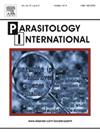Observation of Giardia duodenalis infection in Mongolian gerbils: Cysts isolated from bovine feces
IF 1.9
4区 医学
Q3 PARASITOLOGY
引用次数: 0
Abstract
Assemblage E of Giardia duodenalis, primarily infecting ruminants, has been relatively understudied both in vivo and in vitro. Due to unsuccessful attempts at in vitro cultivation, this study focused on establishing an economical, stable, and clinically relevant experimental animal model for Assemblage E infections. Cysts were purified from bovine feces via 33 % zinc sulfate flotation, with Assemblage E identity confirmed by gdh gene sequencing. Nine five – day - old Mongolian gerbils were randomly allocated into control group (PBS), low-dose group (5 × 104cysts), and high-dose group (1 × 105cysts) averagely, Gerbils were received bovine-derived Assemblage E cysts via oral gavage, all infected subjects were undergone of necropsy at 8 days post-infection. Longitudinal monitoring result demonstrated that gerbils in infected groups exhibited growth retardation and excreted soft feces compared with controls. Histopathological examination result revealed that massive trophozoite were colonized on atrophied duodenal villi, meanwhile, enterocyte boundary was effacement in high-dose group. Scanning electron microscopy (SEM) detection result were showed that the trophozoite density decline along the intestinal tract: duodenum>jejunum>ileum. That could be confirmed the characteristic of trophozoite duodenal tropism. Encystation dynamics analysis was identified bile acid-mediated morphological transformation in the ileum through SEM, the process of encystation with trophozoite rounding, ventral disc degeneration and cyst wall formation. These results could recapitulate the complete life cycle of Assemblage E in experimental hosts, this study provided a validated model for investigating host-specific about giardiasis pathogenesis.
蒙古沙鼠十二指肠贾第虫感染的观察:从牛粪便中分离囊肿
十二指肠贾第鞭毛虫E组合,主要感染反刍动物,在体内和体外的研究相对不足。由于体外培养的尝试失败,本研究的重点是建立一种经济、稳定、具有临床意义的E组装体感染实验动物模型。采用33%硫酸锌浮选法从牛粪便中纯化出囊泡,通过gdh基因测序证实了其组合E的同源性。将9只5日龄的蒙古沙鼠随机分为对照组(PBS)、低剂量组(5 × 104个囊)和高剂量组(1 × 105个囊),分别灌胃牛E组合囊,感染鼠于感染后8 d尸检。纵向监测结果显示,与对照组相比,感染组沙鼠表现出生长迟缓和排泄软粪的现象。组织病理学检查结果显示,大剂量组在萎缩的十二指肠绒毛上定植了大量滋养体,同时肠细胞边界消失。扫描电镜(SEM)检测结果显示,滋养体密度沿肠道(十二指肠、空肠、回肠)呈下降趋势。这可以证实滋养体的十二指肠向性特征。通过扫描电子显微镜(SEM)分析了胆汁酸介导的回肠肠袢形态转变、肠袢与滋养体变圆、腹侧椎间盘退变和囊壁形成过程。这些结果可以概括出E组合在实验宿主中的完整生命周期,为研究贾第虫病宿主特异性发病机制提供了一个验证模型。
本文章由计算机程序翻译,如有差异,请以英文原文为准。
求助全文
约1分钟内获得全文
求助全文
来源期刊

Parasitology International
医学-寄生虫学
CiteScore
4.00
自引率
10.50%
发文量
140
审稿时长
61 days
期刊介绍:
Parasitology International provides a medium for rapid, carefully reviewed publications in the field of human and animal parasitology. Original papers, rapid communications, and original case reports from all geographical areas and covering all parasitological disciplines, including structure, immunology, cell biology, biochemistry, molecular biology, and systematics, may be submitted. Reviews on recent developments are invited regularly, but suggestions in this respect are welcome. Letters to the Editor commenting on any aspect of the Journal are also welcome.
 求助内容:
求助内容: 应助结果提醒方式:
应助结果提醒方式:


